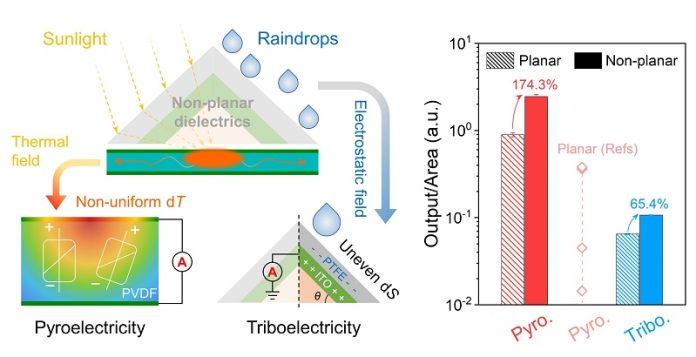
In our modern world, finding new ways to gather energy without harming the environment is becoming more and more important.
As we try to fix the damage caused by pollution and move towards a future where we don’t create more carbon emissions, scientists are looking for creative ways to use the energy that’s all around us – like the warmth from the sun and the power of falling rain.
Until now, most efforts to capture the sun’s heat have used flat, planar devices, which are kind of like thin, flat panels.
These devices work okay, but because they’re all one flat surface, they heat up evenly and slowly, which doesn’t make them very efficient.
Plus, they can’t do anything with rain – which is where another form of energy is just waiting to be used.
That’s why a new study by Professors Jiaqing He and Ghim Wei Ho, along with researcher Yi Zhou, is so exciting.
They’ve been working on a different approach that uses surfaces that aren’t flat – think of the difference between a sheet of paper and a crumpled ball of paper.
These crumpled, curved surfaces are much better at trapping and using energy from both the sun and raindrops.
The way they did this is pretty clever. Instead of using one flat layer, they use multiple layers with curves and bumps. When the sun shines on these layers, they heat up unevenly, which is actually a good thing.
This uneven heating creates more electricity from the heat than a flat surface would.
Imagine a sunny day where some parts of a crumpled ball are in direct sunlight and get hot fast, while other parts are in the shade and stay cooler – that difference in temperature helps generate more power.
But what about the rain? The same bumpy and curved surface that’s good for catching sunlight also helps with rain.
When a raindrop hits this kind of surface, it spreads out more and separates from the surface quickly, which helps generate more electricity.
It’s like the difference between a raindrop splashing on a flat driveway versus a leaf – on the leaf, the water spreads out and runs off quickly, which is what you want to create energy.
The cool part is that they did all this without needing to make the materials – like plastics – any different or more expensive.
They used common materials like fluoropolymer and Teflon, which means this new technology could be cheap to make.
And when they tested it out, they found that they could get a lot more power from both the sun and the rain – over 174% more power from solar heat and 65% more from raindrops.
The scientists even took their new device outside to see how it would do in real-life conditions, testing it on sunny, cloudy, and rainy days, as well as at night. It worked in all these conditions, which shows that it could be a reliable way to gather energy no matter the weather.
Their work shows that there’s a big opportunity to collect energy in new ways that we haven’t used much before.
This isn’t just about getting more power from the sun and rain, either. It’s a whole new approach to using the energy that’s naturally available around us, which could help inspire even more ideas for how to live sustainably and combat climate change.
Follow us on Twitter for more articles about this topic.
Source: KSR.



